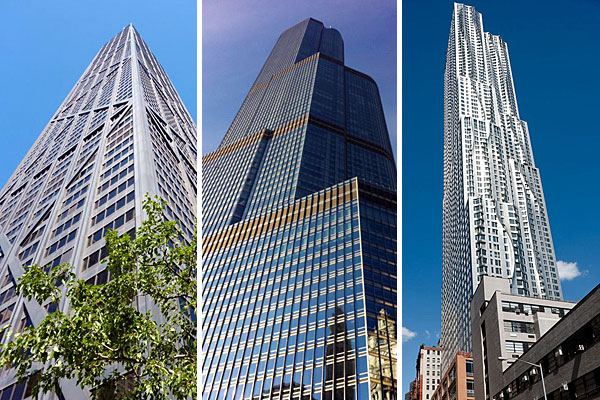
From left: the John Hancock Center, Trump International Hotel & Tower, and 8 Spruce Street, also known as Gehry New York
Chicagoans long ago got used to being snubbed by New York, but one thing that’s hard for New York to overlook is our enviable array of skyscrapers. In addition to having two of the world’s 15 tallest buildings, Chicago has five buildings over 1,000 feet tall—one more than New York. What’s more, three of the world’s 20 tallest buildings completed in 2009 were residential towers in Chicago.
So how is it that a New York City apartment tower designed by Frank Gehry has come to be known as the tallest residential building in the western hemisphere? At 827 feet tall, the building—known both as 8 Spruce Street and Gehry New York—is the world’s 114th tallest. Chicago has two condo buildings that are taller: Trump International Hotel & Tower (1,116 feet tall and the world’s 11th tallest) and the John Hancock Center (1,054 feet, 26th tallest).
Yet since Gehry’s 76-story tower opened last February, the building has been described as the tallest residential building in the western hemisphere by bloggers, real-estate agents, and the building’s own website. In September, New York Mayor Michael Bloomberg repeated the claim, and it showed up again in November in The New York Times.
Turns out this isn’t another case of Manhattan overlooking the Windy City. Instead it’s a matter of definitions—and those definitions originated here in Chicago.
The Council on Tall Buildings and Urban Habitat, headquartered at the Illinois Institute of Technology, maintains a precise set of criteria for measuring and categorizing tall buildings. As the group’s spokesman, Nathaniel Hollister, points out, those criteria say that if 85 percent or more of a building’s total floor area is for one type of use (such as residential), the building counts as being that type of skyscraper. “If you don’t have that percentage, then you’re designated as mixed-use,” Hollister says. (For the Gehry, Trump, and Hancock buildings, I’ve relied on the “occupied”—as opposed to “architectural”—heights provided by the council.)
Retail space, a public school, and other uses fill the lower floors of the Gehry building, just as there’s a hotel at the base of Trump and retail and office floors at the Hancock. But Hollister notes that the difference lies in the percentages. By the council’s count, the Gehry building is residential on floors 9 to 76, or 89 percent of its floor area. Chicago’s Trump is residential on floors 35 to 96, or 65 percent, and the Hancock is residential on floors 45 to 93, or 53 percent.
“According to the criteria, only 8 Spruce Street is purely residential,” Hollister, says—and he thinks that most civilians (not just the architects and engineers who created the council’s criteria) would call Trump a hotel and condo tower and Hancock mixed-use. “One of the innovations of that building is that they used the diminishing floor plates to their advantage, putting residential where the floor was [too small] for offices,” he says.
By the council’s standards, the tallest all-residential building in Chicago is The Legacy at Millennium Park, the 758-foot (73-story) glass tower completed in 2010. And maybe there’s a perverse bit of consolation in this: Chicago can still claim the distinction of having what appears to be the loftiest foreclosed home anywhere in the world.



